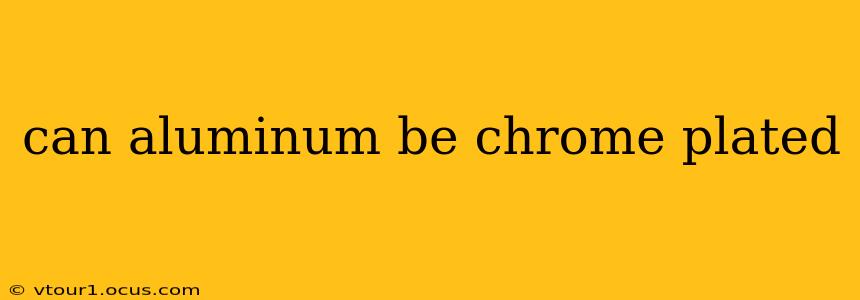Can Aluminum Be Chrome Plated? The Definitive Guide
Yes, aluminum can be chrome plated, but it's not a straightforward process like plating steel or other metals. The challenge lies in aluminum's unique properties and its tendency to react with the plating solutions. This guide will delve into the complexities of chrome plating aluminum, addressing common questions and misconceptions.
What Makes Chrome Plating Aluminum Difficult?
Aluminum's highly reactive nature is the primary hurdle. It forms a tenacious oxide layer upon exposure to air, preventing proper adhesion of the chrome plating. This oxide layer must be meticulously removed and prevented from reforming during the plating process. Failure to do so results in peeling, flaking, and an overall poor-quality finish.
How is Aluminum Chrome Plated?
The process involves several crucial steps to ensure a durable and aesthetically pleasing chrome finish:
-
Surface Preparation: This is arguably the most critical stage. It involves thorough cleaning to remove grease, oils, and contaminants. Then, the aluminum surface undergoes a chemical etching process to remove the existing oxide layer. This often involves alkaline or acid-based cleaners, followed by a chemical or electrochemical process to prepare the surface for plating.
-
Pre-treatment: After etching, a zincate or other conversion coating is typically applied. This acts as an intermediary layer, promoting adhesion between the aluminum substrate and the subsequent chrome layers. This step is essential for long-term durability.
-
Chrome Plating: Once the pre-treatment is complete, the aluminum is ready for chrome plating. This typically uses an electrolytic process, where the aluminum part acts as the cathode in a chrome plating bath. The process involves precise control of current density, temperature, and plating solution composition to achieve the desired thickness and quality.
-
Post-treatment: After plating, the parts may undergo additional processes such as rinsing, passivation (to enhance corrosion resistance), and final polishing to achieve a high-luster finish.
What are the Different Types of Chrome Plating for Aluminum?
While the fundamental process remains similar, different variations exist depending on the desired outcome:
-
Decorative Chrome Plating: Primarily focuses on aesthetics, aiming for a bright, shiny finish. This is commonly used in automotive and decorative applications.
-
Hard Chrome Plating: Emphasizes increased hardness and wear resistance. This is often used in industrial applications where durability is paramount, such as engine parts.
How Long Does Chrome Plating on Aluminum Last?
The longevity of chrome plating on aluminum depends heavily on the quality of the preparation and plating process, as well as the environmental conditions the plated part is exposed to. Properly plated aluminum can last for many years, offering good corrosion resistance. However, improper plating can lead to premature failure.
Is Chrome Plating Aluminum Expensive?
Yes, chrome plating aluminum is generally more expensive than plating other metals. The intricate pre-treatment steps and the need for skilled technicians contribute to the higher cost.
What are the Alternatives to Chrome Plating Aluminum?
Several alternatives offer similar aesthetic or functional properties, sometimes at a lower cost:
- Powder Coating: Provides a durable, colorful finish, offering excellent protection against corrosion.
- Anodizing: An electrochemical process that creates a hard, protective oxide layer on the aluminum surface, available in various colors.
- Painting: A more cost-effective option, although less durable than other methods.
Choosing the right method depends on the specific application and desired properties.
Ultimately, chrome plating aluminum is feasible, but it demands meticulous attention to detail throughout the entire process. The result, however, can be a durable and visually appealing finish, justifying the increased cost and complexity for specific applications.
